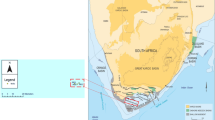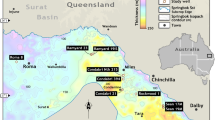Abstract
Four hundred eighty sandstone core samples obtained from three different hydrocarbon charged formations of different geologic ages (Pliocene; Miocene and Cretaceous) and different geographic locations (Egypt and Hungary) are used to correlate the effective pore aperture size adopted by Winland (r35) and new r36 of the present work. These pore aperture percentiles (r35 and r36) are calculated with different empirical equations and correlated with each other to declare which one is effective, simple, and has no additional sources of error. In the present work, new r36 was calculated two times: first from porosity only (Ør36) and the second time from permeability only (Kr36). Both are correlated to r35.The calculated coefficient of correlations between Ør36 and r35 were (R2 = 0.54, 0.71, and 0.73) for the Bahariya, Szolnok, and El Wastani formations, respectively. However, the correlation between Kr36 and r35 is showing very high coefficient of correlations (R2 = 0.9963, 0.9927, and 0.9957) for the Bahariya, Szolnok, and El Wastani formations, respectively. The novel Kr36 could be very helpful to discriminate between dry (pore aperture size < 0.5 μm) and producing wells (pore aperture size > 0.5 μm or 5000 A°) in case of absent of porosity data. Model verification indicates a very close matching between Kr36 and Wr35 vertical profiles in Baltim level III main reservoir (Miocene in age). This confirms the beneficial application of Kr36, which is derived from permeability only, instead of Winland-r35 in all reservoir lithofacies.




Similar content being viewed by others
Abbreviations
- Ø:
-
porosity percentage
- K:
-
permeability, mD
- Ø max, %:
-
maximum porosity
- Ø min, % :
-
minimum porosity
- Ø av, %:
-
average porosity
- K max, :
-
maximum permeability, mD
- K min, :
-
minimum permeability, mD
- K av,:
-
average permeability, mD
- Ør36 max :
-
maximum pore radius 36% calculated from porosity, μm
- Ør36 min:
-
minimum pore radius 36% calculated from porosity, μm
- Ør36 Av:
-
average pore radius 36% calculated from porosity, μm
- Kr36 max:
-
maximum pore radius 36% calculated from permeability, μm
- Kr36min:
-
minimum pore radius 36% calculated from permeability, μm
- Kr36 Av:
-
average pore radius 36% calculated from permeability, μm
- Wr35 max:
-
maximum pore radius 35% calculated from Winland Eq., μm
- Wr35 min:
-
minimum pore radius 35% calculated from Winland Eq., μm
- Wr35Av:
-
average pore radius 35% calculated from Winland Eq., μm
- AEr35-Ør36max:
-
maximum absolute error between r35 and Ør36, μm
- AEr35-Ør36min:
-
minimum absolute error between r35 and Ør36, μm
- AEr35-Ør36Av:
-
average absolute error between r35 and Ør36, μm
- AEr35-Kr36max:
-
maximum absolute error between r35 and Kr36, μm
- AEr35-Kr36min:
-
minimum absolute error between r35 and Kr36, μm
- AEr35-Kr36Av:
-
average absolute error between r35 and Kr36, μm
References
API document (1998) Recommended practices for core analysis, 2nd ed., American Petroleum Institute, document No. API-RP 40, 200 p.
Berg RR (1975) Capillary pressure in stratigraphic traps. AAPG Bull 59:939–956
Cunfei M, Chengyan L, Chunmei D, Derek E, Songtao W, Xiaoqi W, Xiaolong S (2020) Determination of the critical flow pore diameter of shale caprock. Mar Pet Geol 112:104042. https://doi.org/10.1016/j.marpetgeo.2019.104042
Daigle H, Reece JS, Peter BF (2020) A modified Swanson method to determine permeability from mercury intrusion data in marine muds. Mar Pet Geol 113:10415 www.elsevier.com/locate/marpetgeo
El Heiny I, Rizk R, Hassan M (1990) Sedimentological model for Abu Madi reservoir sands, Abu Madi field, Nile Delta, Egypt. 10th Petroleum Exploration and Production Con. EGPC, Cairo 2:515–551
El Sayed AMA (1993) Relationship of porosity and permeability to mercury injection derived parameters for sandstone of the TÖRTÉL Formation, Hungary. Geophys Trans 38(1):35–46
El Sayed AMA (1994) Intercorrelation of capillary pressure derived parameters for the sandstone of the TÖRTÉL Formation, Hungary. Geophys Trans 39(1):77–87
El Sayed AMA (1997) Mutual effects of porosity-permeability and both irreducible water saturation and displacement pressure: the TÖRTÉL Formation, Hungary. Geophys Trans 41(1-2):23–35
El Sayed AMA (2011) Thermophysical study of sandstone reservoir rocks. J Pet Sci Eng 76:138–147
El Sayed AMA, El Sayed NA (2016) Petrophysical properties of clastic reservoirs using NMR relaxometry and mercury injection data: Bahariya Formation, Egypt. Int J Geophys Geochem 3(3):28–32 http://www.aascit.org/journal/ijgg
El Sayed AMA, Kiss B (1997) Reservoir diagnosis for the Szolnok Formation in the middle part of the Great Hungarian Plain. Geophys Trans 41(1-2):37–63
El Sayed AMA, El Sayed NA (2017) Petrophysical study of Szolnok formation, Endrod gas field, Hungary. Pet Environ Bio-technol 8:4(Suppl). https://doi.org/10.4172/2157-7463-C1-034
El Sayed AMA, El Sayed NA (2019) Thermal conductivity calculation from P-wave velocity and porosity assessment for sandstone reservoir rocks. Geothermic 82:91–96
El Sayed AMA et al (2020) Petrophysical properties and permeability prediction for the Abu Madi Formation, Baltim North Gas Field, Nile Delta, Egypt. Int J Eng Res Dev 16(6):15–36
Guo T, Tang S, Liu S, Liu X, Xu J, Qi N, Rui Z (2021) Physical Simulation of hydraulic fracturing of large-sized tight sandstone outcrops. SPE J 26(01):372–393.Paper Number: SPE-204210-PA. https://doi.org/10.2118/204210-PA
Kashif M, Cao Y, Yuan G, Asif M, Javed K, Mendez JN, Khan D, Miruo L (2019) Pore size distribution, their geometry and connectivity in deeply buried Paleogene Es1 sandstone reservoir, Nanpu Sag, East China. Pet Sci 16:981–1000. https://doi.org/10.1007/s12182-019-00375-3
Keelan DK (1972) A critical review of core analysis techniques. J Can Pet Technol 2:42–55
Kolodzie S Jr (1980) Analysis of pore throat size and use of the Waxman-Smits equation to determine OOIP in Spindle Field, Colorado: Society of Petroleum Engineers, 55th Annual Fall Technical Conference, Paper SPE-9382, 10 p
Lai J, Wang G, Cao J, Xiao C, Wang S, Pang X, Dai Q, He Z, Fan X, Yang L, Qin Z (2018) Investigation of pore structure and petrophysical property in tight sandstones. Mar Pet Geol 91:179–189
Liua C, Changhai Y, Lu J, Sun L, Wang Y, Hu B, Li J (2020) Pore structure and physical properties of sandy conglomerate reservoirs in the Xujiaweizi depression, northern Songliao Basin, China. J Pet Sci Eng 192. https://doi.org/10.1016/j.petrol.2020.107217
Lui Y, Liu Y, Liu Q, Zhang C, Li Y, Feng Y, Wang Y, Xue H, Ma S (2019) Petrophysical static rock typing for carbonate reservoirs based on mercury injection capillary pressure curves using principal component analysis. https://doi.org/10.1016/j.petrol.2019.06.039
Lv Y, Fu G, Zhang F, Fu X, Wang X (2000) Quantitative study on sealing ability of Ultra - pressure caprock. Acta Sedimentol Sin 18(3):465–468
Nwachukwu C (2018) Machine learning solutions for reservoir characterization, management, and optimization, Petroleum and Geosystems Engineering: UT Austin Home, Austin
Pittman ED (1992) Relationship of porosity and permeability to various parameters derived from mercury injection-capillary pressure curves for sandstones. AAPG Bull 76(2):191–198
Pittman ED (2001) Estimating pore throat size in sandstones from routine core-analysis data. Search and Discovery Article #40009
Qiao J, Zeng J, Jiang S, Maa Y, Feng S, Xie H, Wang Y, Hu U (2020) Role of pore structure in the percolation and storage capacities of deeply buried sandstone reservoirs: a case study of the Junggar Basin, China. Mar Pet Geol 113:104129 www.elsevier.com/locate/marpetgeo
Rezaee R, Saeedi A, Clennell B (2012) Tight gas sands permeability estimation from mercury injection capillary pressure and nuclear magnetic resonance data. J Pet Sci Eng 88–89:92–99
Saba K (2018) Machine learning algorithms in hydrocarbon exploration and reservoir characterization. A Ph.D. Dissertation, Faculty of the Geosciences, 163p., The University of Arizona, USA
Schmitt MC, Fernandes P, da Cunha Neto JA, Wolf FG, dos Santos VS (2013) Mar Pet Geol 39:138
Schowalter TT (1979) Mechanics of secondary hydrocarbon migration and entrapment. AAPG Bull 63:723–760
Smith DA (1966) Theoretical considerations of sealing and non-sealing faults. AAPG Bull 50:363–374
Soumi C (2015) Reservoir characterization: a machine learning approach, MSc. Thesis, Indian Institute of Technology, Kharagpur, 67 p, India
Sujuan Y, Zhengxiang L, Rong L (2011) Petrophysical and capillary pressure properties of the upper Triassic Xujiahe Formation tight gas sandstones in western Sichuan, China. Pet Sci 8:34–42
Swanson BF (1977) Visualizing pores and non-wetting phase in porous rocks: Society of Petroleum Engineers, Annual Fall Technical Conference, SPE Paper 6857, 10 p
Swanson BF (1981) A simple correlation between permeabilities and mercury capillary pressures. J Pet Technol 33(12):2498–2504. https://doi.org/10.2118/8234-PA
Tang Y, Hou C, He Y, Wang Y, Chen Y, Rui Z, 2020, Review on pore structure characterization and microscopic flow mechanism of CO2 flooding in porous media., First published: 10 November 2020, https://doi.org/10.1002/ente.202000787
Wang L, Zhang Y, Zhang N, Zhao C, Xu WW (2020) Pore structure characterization and permeability estimation with a modified multimodal Thomeer pore size distribution function for carbonate reservoirs. J Pet Sci Eng 193:107426
Washburn EW (1921) Note on a method of determining the distribution of pore sizes in a porous material. Proc Natl Acad Sci 7:115–116. https://doi.org/10.1103/PhysRev.17.273©1921 American Physical Society
Wei Y, Qianyou W, Yaohua W, Zhenxue J, Yan S, Lid Y, Dan L, Rusi Z, Xiaomin G, Fan Z (2020) Pore characteristic responses to categories of depositional microfacies of delta-lacustrine tight reservoirs in the Upper Triassic Yanchang Formation, Ordos Basin, NW China. Mar Pet Geol 118:104423. https://doi.org/10.1016/j.marpetgeo.2020.104423
Zhong H, Yang T, Yin H, Lu J, Zhang K, Fu C (2020) Role of alkali type in chemical loss and ASP-flooding enhanced oil recovery in sandstone formations. SPE Reserv Eval Eng 23(02):431–445. Paper Number: SPE-191545-PA. https://doi.org/10.2118/191545-PA
Acknowledgements
Authors would like to acknowledge the facilities given in Lab. measurements by both Geothermal System Analysis, LIAG-Institute, Hannover-Germany (First Author’s DAAD Scholarship); MOL (Hungarian Oil and Gas Lab.), Petrophysical Research Unit, PRU-Ain shams University. Authors appreciate the EGPC, Badr El Din, Belayim and Khalda Petroleum Companies, Egypt for their facilities and permission to use the technical data and publish this study. Authors express their deepest indebtedness to the editor and anonymous reviewers for their valuable recommendations and constructive ideas that enhanced our manuscript.
Author information
Authors and Affiliations
Corresponding author
Ethics declarations
Conflict of interest
The authors have not declared any conflict of interest regarding the publication of this paper.
Additional information
Responsible Editor: Santanu Banerjee
Supplementary Information
ESM 1
(DOCX 81 kb)
Rights and permissions
About this article
Cite this article
El Sayed, A.M.A., El Sayed, N.A. Pore aperture size (r36) calculation from porosity or permeability to distinguish dry and producing wells. Arab J Geosci 14, 866 (2021). https://doi.org/10.1007/s12517-021-07185-1
Received:
Accepted:
Published:
DOI: https://doi.org/10.1007/s12517-021-07185-1




